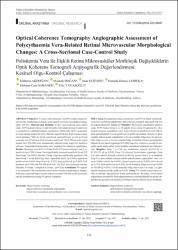Optical coherence tomography angiographic assessment of polycythaemia vera-related retinal microvascular morphological changes: A cross-sectional case-control study

View/
Access
info:eu-repo/semantics/openAccessDate
2022Author
Akdoğan, MüberraDoğan, Mustafa
Gobeka, Hamidu Hamisi
Şabaner, Mehmet Cem
Elizade, Anar
Yavaşoğlu, Filiz
Metadata
Show full item recordCitation
AKDOĞAN, M., DOĞAN, M., ELİZADE, A., GOBEKA, H. H., SABANER, M. C., & YAVAŞOĞLU, F. (2022). Optical Coherence Tomography Angiographic Assessment of Polycythaemia Vera-Related Retinal Microvascular Morphological Changes: A Cross-Sectional Case-Control Study. Turkiye Klinikleri Journal of Ophthalmology, 31(3).Abstract
Objective: To assess polycythaemia vera (PV)-related retinal mi crovascular morphological changes using optical coherence tomography angiography (OCTA). Material and Methods: In this cross-sectional case-control study, 30 PV patients (Group 1) and 30 healthy individuals (Group 2) underwent a comprehensive ophthalmological examination, followed by OCTA acquisition in Angio Retina mode (6x6 mm). Macular superficial and deep vascular plexus vessel densities (VDs) in foveal, parafoveal, and perifoveal, as well as foveal avascular zone (FAZ) area, FAZ perimeter, and foveal VD in 300-µm wide region around FAZ (FD-300) were automatically analysed using AngioVue Analytics software. Sequential measurements were compared for statistical significance. Results: Mean ages were 46.97±3.20 and 47.42±2.55 years in Groups 1 and 2, respectively (p=0.350). Group 1 had significantly increased superficial foveal VD than Group 2 (p=0.032). Besides, Group 1 had non-significantly increased VDs than Group 2 in the following areas: superficial whole (p=0.468), superficial parafoveal (p=0.692), deep foveal (p=0.752), deep perifoveal (p=0.369), FAZ perimeter (p=0.209), and FD-300 (p=0.914). The FAZ area decreased non-significantly in Group 1 compared to Group 2 (p=0.529). Conclusion: PV appears to be associated with considerable retinal microvascular morphological changes, indicating a potential hyperviscosity impact on retinal VDs that would necessitate careful consideration during PV patient evaluation.















